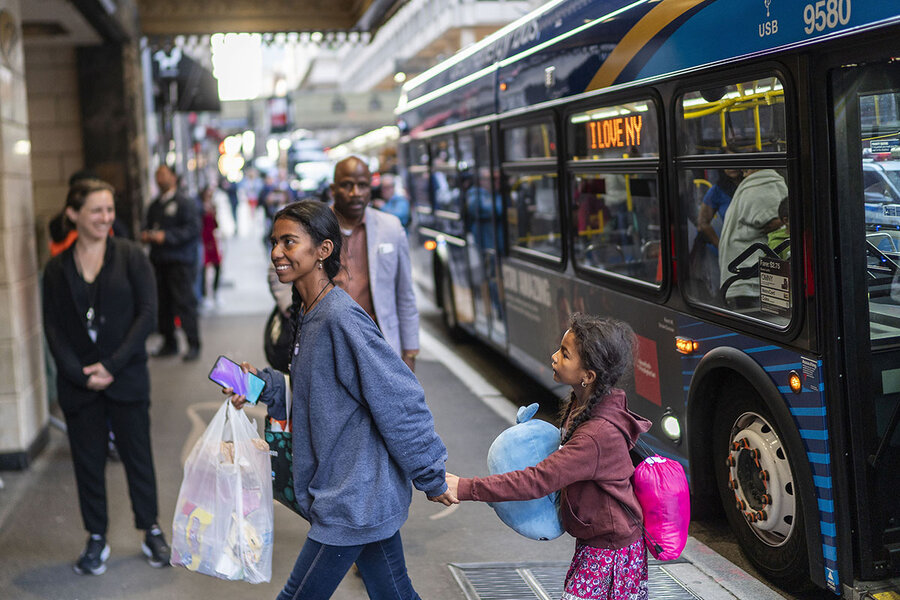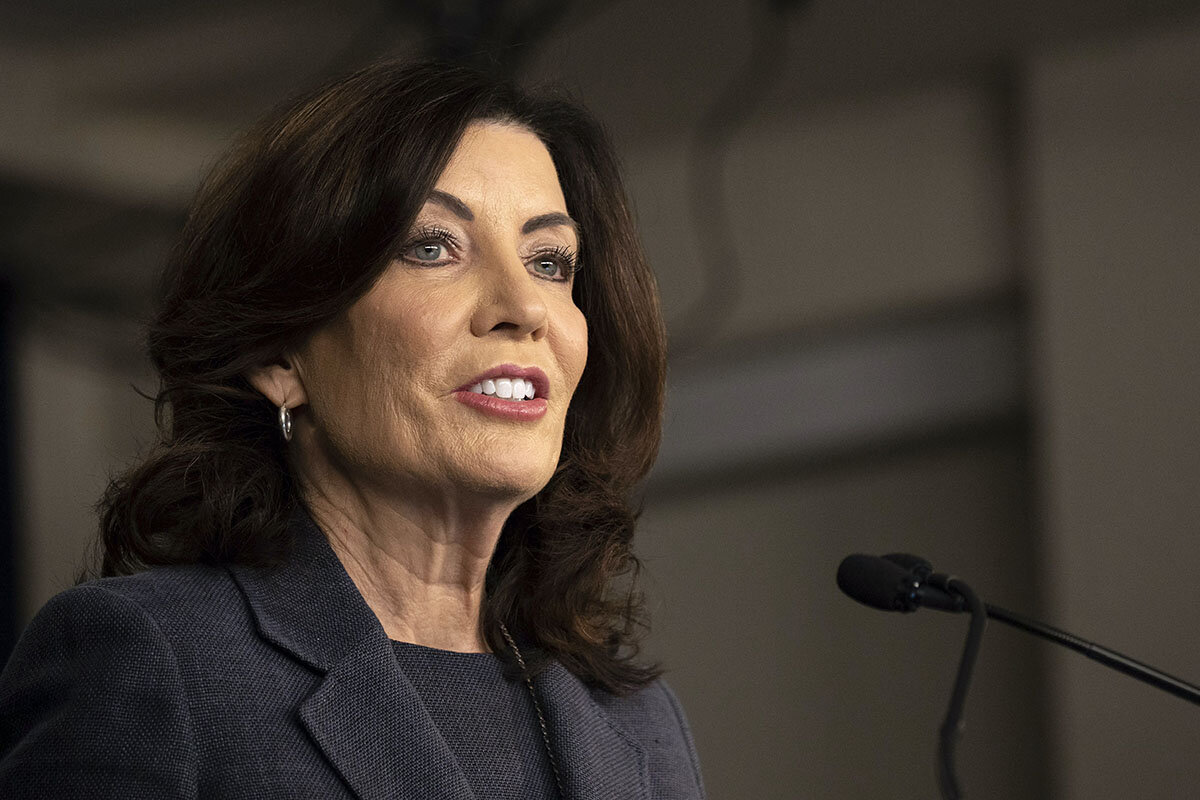Are jobs the solution to New York’s migrant crisis?
| New York
Can the staggering number of migrants arriving in New York help to fill thousands of open jobs in the region?
New York Gov. Kathy Hochul argues yes. “We have all these people who want to be here. I have all these jobs that are open. You marry the two together, and you’ve solved the problems,” she said last fall while announcing job openings for qualified migrants.
In an effort to ease the financial crunch of supporting recent arrivals, Governor Hochul and New York City Mayor Eric Adams have touted new programs, like work authorization clinics and a jobs portal, to more quickly match migrants with work opportunities.
Why We Wrote This
A story focused onNew York is mobilizing to connect migrants with open jobs in an effort to ease the financial crunch of supporting thousands of newcomers in government care.
For migrants, the formula for finding a lawful job is not so simple.
Legal work is complicated by bureaucratic hurdles and limited knowledge of the U.S. job hunt. Despite a tight labor market, companies are often hesitant to hire authorized foreigners due to concerns about language barriers and lack of domestic work history. Yet there’s increased momentum, by officials strained by the cost of supporting migrants, to help newcomers move more quickly toward self-sufficiency.
“Right now, we need labor, and these people are desperate to [earn money],” says David Reimers, a professor emeritus at New York University and expert on immigration history. Elected officials haven’t taken this tack before, but it makes sense given the country’s low unemployment rate, he says.
“Honest, dignified” work
In a tight Bronx conference room last month, 25 people from across Latin America gathered to learn safety regulations necessary for construction work. Among them: a mechanic, doctor, business owner, and sales representative.
For these migrants, the prospect of finding work in their previous professions isn’t a consideration. They say that they’re willing to take any lawful job to support their families, even if it means accepting low wages or relocating.
Rosanny, a Venezuelan doctor, attended the training run by Catholic Charities of New York. She left home in 2019 because her country lacked medical supplies to treat patients. After four years in Ecuador, she says, she fled with her partner and toddler to the United States to escape kidnappers. As she awaits work authorization, Rosanny cleans houses for $100 a day and gives $40 therapeutic messages.
“I’ll do any work that’s honest, dignified,” she says through a translator. She’s willing to labor in any field, including construction, and hopes to work in health care, she adds.
Rosanny, like others interviewed, asked to be identified by her first name alone. She is one of 168,500 asylum-seekers and migrants who have arrived in New York City since spring 2022, with approximately 69,000 still relying on city services, according to Mayor Adams’ office. This support has cost the city $1.7 billion, a number that continues to grow.
Officials hope that by speeding work permits, more people can move out of government shelter and into their own housing. In October, the state had about 466,000 of the country’s 8.8 million open jobs, according to the U.S. Bureau of Labor Statistics.
Under U.S. law, migrants who are paroled into the country or who are asylum-seekers can apply to work legally while their immigration cases are pending. Federal officials recently cut down on processing times, but the wait for authorization can take anywhere from one month to over a year. Asylum-seekers must wait an additional 150 days after submitting their asylum application before applying for work credentials.
While migrants wait, many rely on public resources or take low-paying and unreliable, under-the-table gigs.
Current migrants face the same challenges as their predecessors – low wages and poor working conditions in order to provide better futures for their families, says C. Mario Russell, executive director at the Center for Migration Studies in New York.
Yet today’s migrants, many of whom are asylum-seekers, can access support systems not offered just a few years ago. Nonprofits, volunteers, and city and federal agencies offer paperwork assistance, legal help, English lessons, settlement, and job advice. Demand, however, far outstrips resources.
Identifying partnerships
State officials also are working to identify private-sector job opportunities for migrants. Governor Hochul announced in October that the state had secured some 18,000 jobs for authorized workers in various industries; by December, the state Department of Labor listed nearly 40,000 job openings for eligible migrants. Some states – such as Illinois, Indiana, and Utah – want permission from Washington to sponsor migrants to fill critical job openings.
In late December, the attorney general of New York and 17 other state attorneys general called on Washington to accelerate migrant work access by taking steps such as eliminating application fees and granting provisional work. Critics say such actions encourage illegal crossings.
Some employers are hesitant to hire even authorized migrants. David Kholodorov owns a barbershop and a restaurant in Manhattan. An émigré from Russia, he now employs two documented, immigrant barbers. Nonetheless, he considers it a gamble to hire someone without verifiable references.
Although many unauthorized immigrants pay U.S. payroll taxes, critics say the revenue doesn’t cover the cost of services they use. Besides, vacancies should be filled by U.S. citizens, not foreigners, says Steven Camarota, director of research at the Center for Immigration Studies.
While some individuals crossing into America may not want to work, the vast majority are so determined that they’re willing to walk the almost 3,000 miles to get here, says Anna Hidalgo, a faculty fellow in sociology at New York University who studies Venezuelan migrants in New York City.
“If you have the gumption to cross the Darién Strait, to make that journey, you are cut from a different cloth. You are someone who is going to do what it takes to move forward to a better life for you and your children and your family, which is all these folks talk about,” she says.
Rosanny, the Venezuelan doctor, anticipates a 150-day wait for her work authorization to arrive. Until then, she’ll take small-scale jobs, attend English class, and do whatever is necessary for a better life.
“I’m very grateful,” she says. “I understand the American dream isn’t just to come here. It takes action to make it happen. I have to be creative.”
Mercedes Cardona contributed to this report.
Editor's note: This article has been updated to clarify how long asylum seekers must wait before applying for work authorization.






